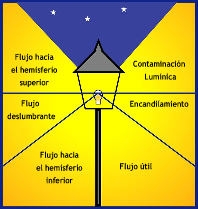Light pollution is a problem that greatly affects observational astronomy, perhaps to a greater extent amateur activity. This is the name given to all the light that is not used to illuminate the ground and buildings, but rather diffuses into the sky and ends up being wasted, with a consequent economic and ecological cost, since this prevents the objects from being appreciated with sufficient clarity. celestial bodies.
How does light pollution occur?
 1) Bad arrangement of the luminaires. It is the most typical cause, and is that the luminaires are not pointing strictly downwards; This implies that there is light being wasted and dispersed in the sky, preventing us from seeing the sky clearly; In turn, water or dust molecules help this light to disperse even more, potentially obstructing the vision of a nearby observatory; In other words, without the need for a city to be directly visible to an observatory, these phenomena make light pollution a clearly harmful factor for astronomy, amateur or professional.
1) Bad arrangement of the luminaires. It is the most typical cause, and is that the luminaires are not pointing strictly downwards; This implies that there is light being wasted and dispersed in the sky, preventing us from seeing the sky clearly; In turn, water or dust molecules help this light to disperse even more, potentially obstructing the vision of a nearby observatory; In other words, without the need for a city to be directly visible to an observatory, these phenomena make light pollution a clearly harmful factor for astronomy, amateur or professional.
2) Light radiation at non-visible wavelengths. It consists of certain radiation emitted by a luminaire being at wavelengths that the human eye does not perceive, therefore they are an extra and unnecessary polluting factor. This is also extremely harmful, since if the radiation from lights also has the same wavelengths as some weak stars, they will simply cease to be visible. Many luminaires are not designed in a way that optimizes their radiation at wavelengths strictly visible to humans.
You can see a magnitude of the problem, both at the level of Chili (country recognized for having one of the clearest skies in the world), as well as some examples of light pollution, in the respective subsections shown in the side column.


